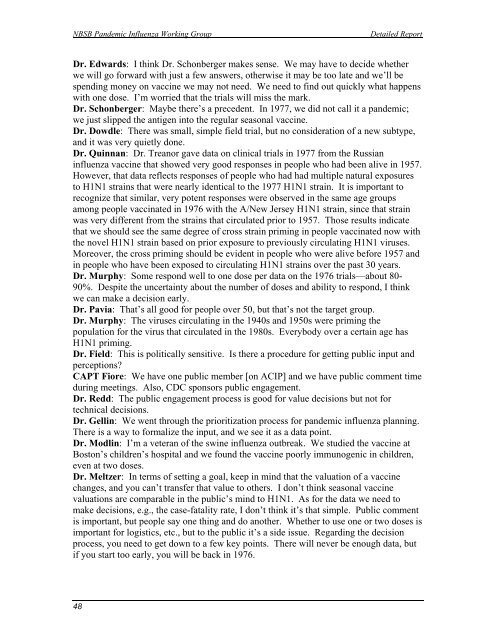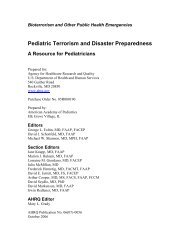H1N1 COUNTERMEASURES STRATEGY AND ... - PHE Home
H1N1 COUNTERMEASURES STRATEGY AND ... - PHE Home
H1N1 COUNTERMEASURES STRATEGY AND ... - PHE Home
You also want an ePaper? Increase the reach of your titles
YUMPU automatically turns print PDFs into web optimized ePapers that Google loves.
NBSB Pandemic Influenza Working Group<br />
Detailed Report<br />
Dr. Edwards: I think Dr. Schonberger makes sense. We may have to decide whether<br />
we will go forward with just a few answers, otherwise it may be too late and we’ll be<br />
spending money on vaccine we may not need. We need to find out quickly what happens<br />
with one dose. I’m worried that the trials will miss the mark.<br />
Dr. Schonberger: Maybe there’s a precedent. In 1977, we did not call it a pandemic;<br />
we just slipped the antigen into the regular seasonal vaccine.<br />
Dr. Dowdle: There was small, simple field trial, but no consideration of a new subtype,<br />
and it was very quietly done.<br />
Dr. Quinnan: Dr. Treanor gave data on clinical trials in 1977 from the Russian<br />
influenza vaccine that showed very good responses in people who had been alive in 1957.<br />
However, that data reflects responses of people who had had multiple natural exposures<br />
to <strong>H1N1</strong> strains that were nearly identical to the 1977 <strong>H1N1</strong> strain. It is important to<br />
recognize that similar, very potent responses were observed in the same age groups<br />
among people vaccinated in 1976 with the A/New Jersey <strong>H1N1</strong> strain, since that strain<br />
was very different from the strains that circulated prior to 1957. Those results indicate<br />
that we should see the same degree of cross strain priming in people vaccinated now with<br />
the novel <strong>H1N1</strong> strain based on prior exposure to previously circulating <strong>H1N1</strong> viruses.<br />
Moreover, the cross priming should be evident in people who were alive before 1957 and<br />
in people who have been exposed to circulating <strong>H1N1</strong> strains over the past 30 years.<br />
Dr. Murphy: Some respond well to one dose per data on the 1976 trials—about 80<br />
90%. Despite the uncertainty about the number of doses and ability to respond, I think<br />
we can make a decision early.<br />
Dr. Pavia: That’s all good for people over 50, but that’s not the target group.<br />
Dr. Murphy: The viruses circulating in the 1940s and 1950s were priming the<br />
population for the virus that circulated in the 1980s. Everybody over a certain age has<br />
<strong>H1N1</strong> priming.<br />
Dr. Field: This is politically sensitive. Is there a procedure for getting public input and<br />
perceptions?<br />
CAPT Fiore: We have one public member [on ACIP] and we have public comment time<br />
during meetings. Also, CDC sponsors public engagement.<br />
Dr. Redd: The public engagement process is good for value decisions but not for<br />
technical decisions.<br />
Dr. Gellin: We went through the prioritization process for pandemic influenza planning.<br />
There is a way to formalize the input, and we see it as a data point.<br />
Dr. Modlin: I’m a veteran of the swine influenza outbreak. We studied the vaccine at<br />
Boston’s children’s hospital and we found the vaccine poorly immunogenic in children,<br />
even at two doses.<br />
Dr. Meltzer: In terms of setting a goal, keep in mind that the valuation of a vaccine<br />
changes, and you can’t transfer that value to others. I don’t think seasonal vaccine<br />
valuations are comparable in the public’s mind to <strong>H1N1</strong>. As for the data we need to<br />
make decisions, e.g., the case-fatality rate, I don’t think it’s that simple. Public comment<br />
is important, but people say one thing and do another. Whether to use one or two doses is<br />
important for logistics, etc., but to the public it’s a side issue. Regarding the decision<br />
process, you need to get down to a few key points. There will never be enough data, but<br />
if you start too early, you will be back in 1976.<br />
48
















